FAQ Chatbots: Everything You Need to Know
Home » FAQ Chatbots: Everything You Need to Know
Support costs are climbing. User patience is shrinking. AI adoption is accelerating fast. In this environment, FAQ chatbots have become a critical tool, not a convenience.
Gartner predicts that by the end of 2025, 80% of routine support queries will be resolved autonomously, without any human involvement. And nearly 7 in 10 users now prefer self-service over waiting for an agent to respond. That gap between what customers expect and what many companies still deliver? It’s costing you time, money, and retention.
This article unpacks exactly what FAQ chatbots are, how they work, and what sets different types apart. We’ll cover benefits, use cases by industry, and how to build one—without writing a single line of code—using NoForm AI.
If you’re evaluating whether a chatbot belongs in your support stack, start here!
What is an FAQ chatbot?
An FAQ chatbot (also known as a FAQ bot, chatbot for FAQ, or Q&A chatbot) is a type of conversational AI bot designed to automatically answer frequently asked questions from customers. It lives on your website, app, or messaging platform, and responds instantly to user queries about your products and services. All without any scrolling, searching, or waiting.
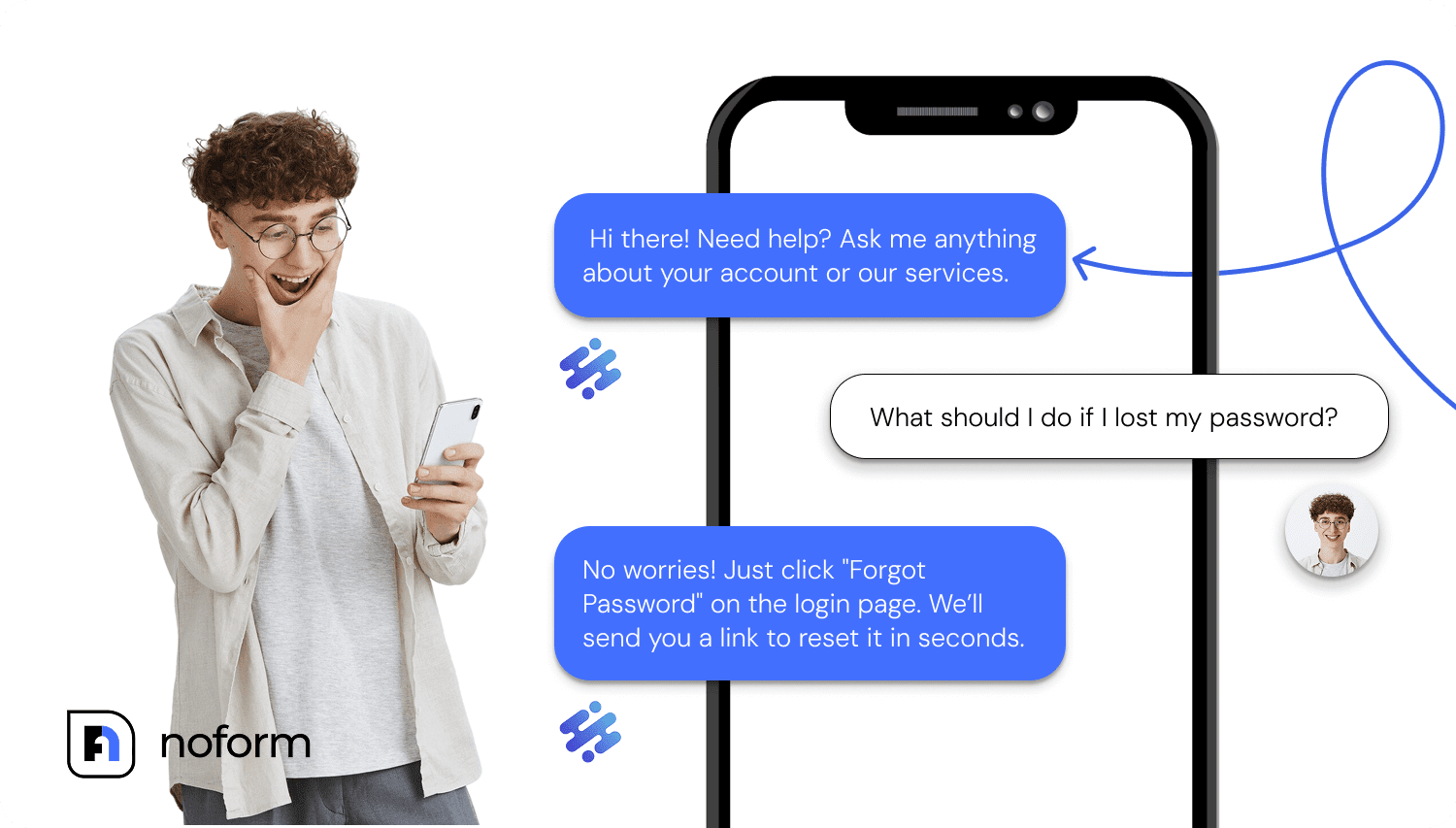
It’s essentially a virtual assistant trained on your business’s FAQ database or knowledge base. When someone asks a question—anything from “How do I reset my password?” to “Is there a discount for nonprofits?”—the FAQ bot analyzes the query and returns the most relevant answer.
Static FAQ pages vs FAQ chatbots
Most businesses start with a standard FAQ page—a long, static list of common questions and answers. It works fine if your customers enjoy sifting through a wall of text. But most don’t. People want quick answers, and they want them in their own words.
An FAQ chatbot flips that experience. Instead of guessing the right keywords or scrolling endlessly, users type a question—and the bot replies like a human agent would (only faster). It handles follow-ups, special offer suggestions, and doesn’t care if someone phrases the question in a completely unexpected way. That’s something static pages can’t do.
Although not every FAQ bot is capable of that either…
Rule-based bots vs AI-powered tools
There are different types of chatbot technologies, and not all are created equal. A rule-based chatbot works on a set of predefined keywords or decision trees. It’s limited, rigid, and easily thrown off by phrasing it wasn’t programmed to handle. For example, it might recognize “return policy” but stumble on “how do I send this back?”
In contrast, conversational AI chatbots use advanced language models and contextual understanding to simulate more fluid, human conversation. These bots can recognize the intent behind a question (yes, even if it’s vague, informal, or incomplete) and still deliver an accurate answer.
Aspect | Rule-based chatbot | AI-powered FAQ bot |
Technology | Decision trees, keywords | Natural language processing, machine learning |
Understanding user intent | Basic keyword matching | Context-aware and intent-driven |
Flexibility in conversation | Rigid, limited phrasing required | Handles varied and informal language |
Learning over time | Static—doesn’t improve | Learns from user interactions |
Accuracy with complex queries | Low | High |
User experience | Scripted, impersonal | Conversational, dynamic |
Maintenance | Manual updates needed | Self-improving with feedback |
Escalation to human agent | Limited or none | Smart hand-off when needed |
Best suited for | Basic, repetitive questions | Complex, high-volume customer support |
The core technology that powers modern FAQ chatbots is natural language processing (NLP), a subset of artificial intelligence that helps bots understand how humans actually speak. Combined with machine learning, the bot can improve its accuracy by analyzing patterns in user behavior over time.
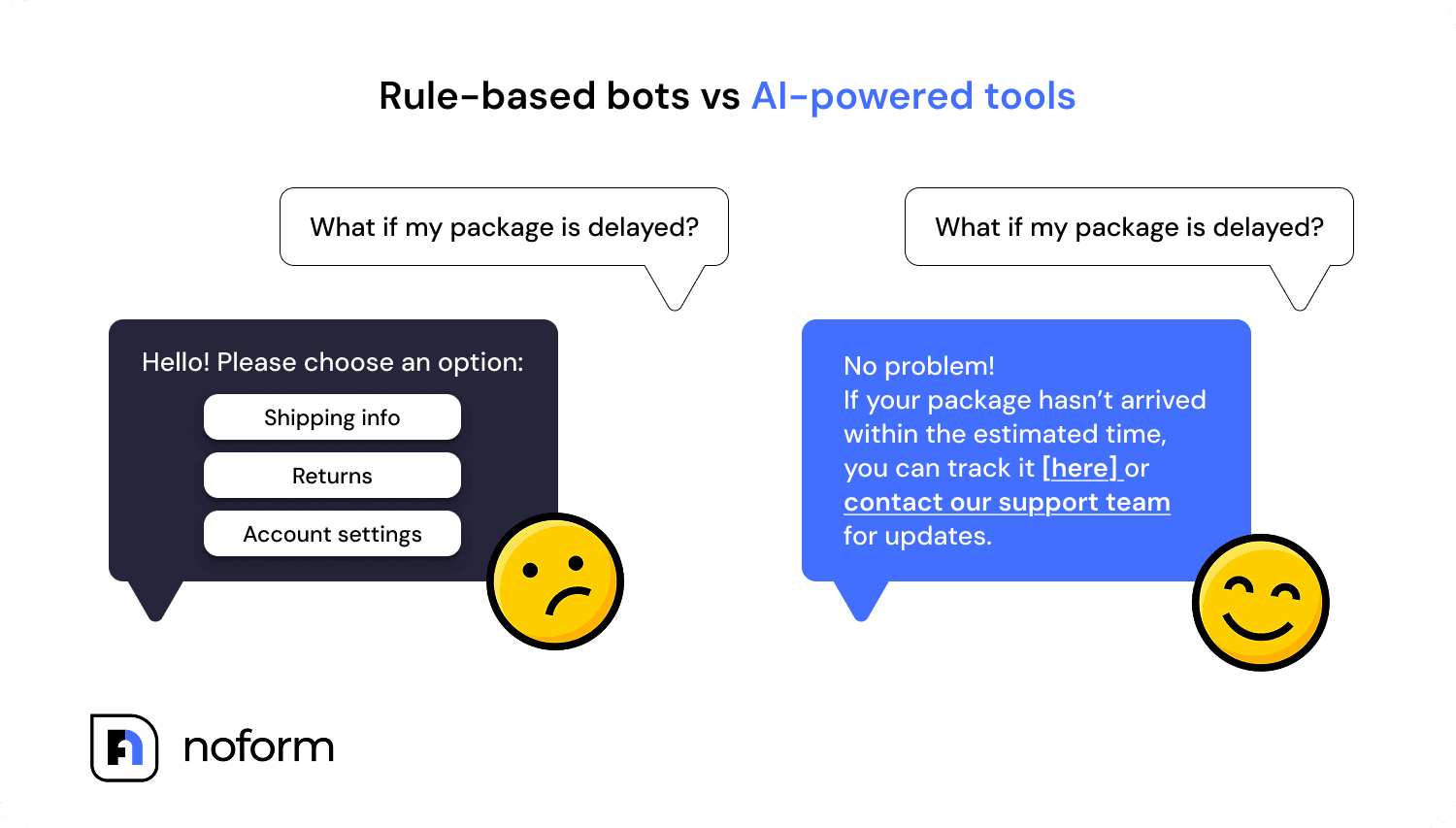
What’s changed dramatically in the last few years is the rise of transformer-based models like GPT, Claude, and other large language models. Unlike earlier systems that relied solely on keyword recognition, these advanced models grasp context, nuance, and even messy, human phrasing. That shift means FAQ bots can move beyond surface-level matching to actually understand what users are asking—delivering a smoother, smarter user experience.
Despite all this progress, many companies still rely on rule-based chatbots. Why? They’re cheaper. They’re easy to deploy. And they don’t require much setup. But they also fall apart the moment a common query comes in with slightly unusual phrasing or user intent.
For any business that cares about reducing response time, deflecting repetitive questions, and delivering a positive customer service experience, clinging to outdated bots is a missed opportunity. Beyond just a tech upgrade, modern FAQ bots—powered by AI—are a leap in how you handle real customer needs, in real time.
Benefits of using an FAQ chatbot
Not just another tool in your tech stack, FAQ chatbots are a direct line to better service, smoother operations, and measurable results.
For businesses juggling rising customer demands and limited team bandwidth, they offer a smarter way to answer frequently asked questions, speed up resolutions, and improve the overall experience for users.
And for enterprises with large teams and high support volumes, chatbot FAQs bring consistency, faster scale, and the kind of operational efficiency that even the biggest customer support team can’t match.
Here’s exactly what a well-designed FAQ chatbot offers and why it belongs in your business strategy:
- Reduce customer support costs: Take pressure off your team with instant responses around the clock, cut ticket volume through smart self-service, and route complex conversations to a human only when necessary.
“The chatbot is really helping me control my costs. So I can still spend my time with the clients, one-to-one, but it like doubles what I’m able to do as one person.”
—Rebecca Henning, Dog Gone Taxi
- Streamline internal operations: Automate repetitive inquiries across HR, IT, and onboarding to lighten the load on internal teams. Easily pull in content from your knowledge base, site URLs, or PDFs—no coding skills needed. Then connect it all to your CRM or CMS to personalize responses and keep workflows running seamlessly.
- Ensure consistent, compliant communication: Keep messaging aligned with policy by using pre-approved answers, and stay ahead of regulations with GDPR and CCPA safeguards built in from day one.
- Improve customer satisfaction and response time: Provide accurate, natural replies that feel conversational, maintain context across multiple messages, and deliver a faster resolution that boosts customer satisfaction.
“People want answers now, not tomorrow. When given the choice between filling out a form and waiting for a response versus getting immediate help from our chatbot, the decision was obvious. NoForm AI isn’t just an alternative—it’s the preferred way for our users to get assistance.”
—Stefani Sparysheva, Cheqmark
- Offer multilingual support: Automatically detect and translate user input to ensure a smooth, localized experience that feels native for every customer, in every market.
- Gain insights from customer interactions: Use the chatbot platform’s built-in analytics and reporting dashboards to track key metrics and study real-time user interactions. Identify common pain points, spot content gaps, and monitor which chatbot offers get ignored or clicked. Collect feedback directly from users to drive continuous improvement and create a more positive experience for users.
Finally, beyond support and efficiency, FAQ chatbots also drive lead generation. By acting as the first touchpoint in the customer journey, they engage visitors early and guide them toward conversion. In fact, after deploying a chatbot, Dog Gone Taxi saw a 37% visitor-to-chat engagement rate—resulting in more qualified leads and fewer manual tasks for their team.
Different types of FAQ chatbots
We’ve already covered the key divide between rule-based chatbots and AI-powered bots. But if you’re building a serious FAQ chatbot strategy, you’ll want to look deeper. Each type of chatbot comes with its own capabilities, strengths, and trade-offs. Choosing the right chatbot—the one that truly suits your needs—is what separates a seamless support experience from a frustrating one.
Here’s a breakdown of the most common types, what they’re good at, and where they fall short.
Rule-based chatbots
The simplest option, rule-based chatbots follow a decision tree model, where users select from predefined choices that lead to specific responses.
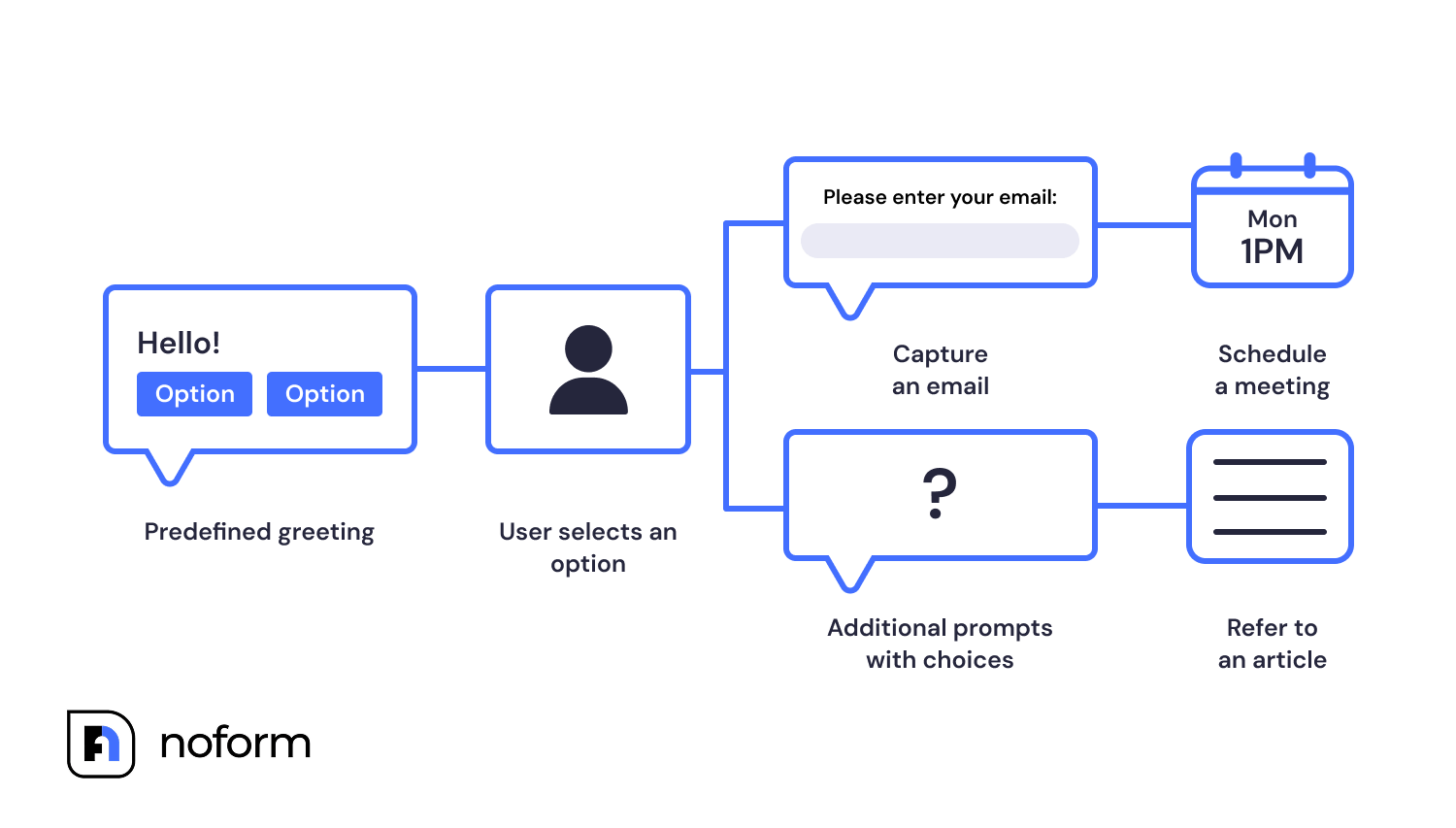
They’re fast to deploy and easy to manage, especially if you’re dealing with a tight, predictable set of queries. Most are designed to answer common questions and can be useful in environments with clear workflows, like tracking an order or booking an appointment.
But they fall apart with ambiguity. Ask a complex query, or anything even slightly off-script, and these bots won’t adapt.
As a rule of thumb, use them only if your support needs are narrow and consistent. Their feature ratio is low, but so is the cost.
Keyword-triggered chatbots
A small step up from rule-based, a keyword-based chatbot relies on keyword detection to deliver responses. Think of it as a more flexible rule system: it listens for specific words or phrases and serves a matching answer. This approach helps widen the bot’s understanding without jumping into full AI territory.
It performs well for FAQs that include variable phrasing, but without deeper logic, it still struggles with context or nuance. Compared to an AI chatbot, it lacks learning capabilities and can’t follow the thread of a conversation.
Still, for fast deployments on a budget, it’s a practical middle ground.
AI FAQ chatbots
This is where conversation bots go from reactive to intelligent. An AI chatbot built on large language models (LLMs) can parse meaning, understand user intent, and manage follow-ups through contextual memory. It’s built to handle a wide range of phrasing, manage complex queries, and deliver natural responses in real time—even when the input is far from a common user question.
If you want real flexibility and better real-time updates, this is the type of chatbot that scales with your business. But it comes at a higher implementation cost and may require training or integrations with your knowledge base. Still, for teams aiming to deliver a true AI FAQ experience and automate even complex FAQs, it’s hard to beat.
Hybrid chatbots
A hybrid chatbot for customer support blends the best of both: rule-based flows for structure, plus AI capability for flexibility. It handles predictable FAQs quickly, while still managing edge cases or escalating to a human when needed.
Compared to standalone AI models, hybrids are more manageable and less prone to veering off-topic. And unlike rigid rule-based bots, they’re better equipped to scale across mobile apps, websites, or any communication platform you’re using.
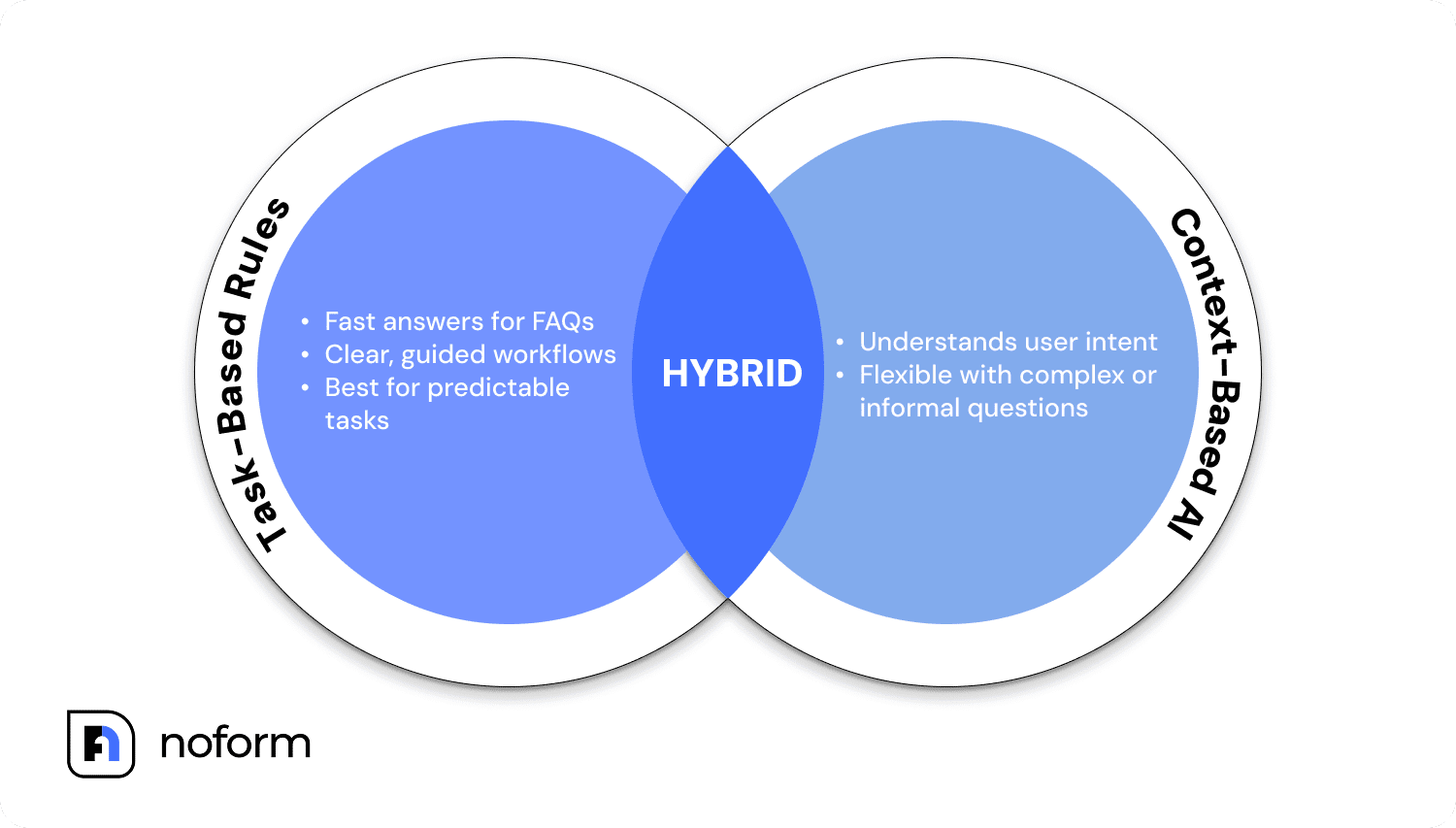
For most businesses, especially those balancing automation with a human touch, this is often the smartest move.
Types of chatbots based on deployment
The type of chatbot matters. But so does where you put it. Some run as embedded widgets, like NoForm AI’s lightweight script that can be added to any website in seconds. Others live inside third-party channels like Messenger, WhatsApp, Slack, or even your internal mobile apps—wherever your users are already active.
The key is choosing a deployment channel that fits your audience. A chatbot won’t help much if it’s hidden away. To actually deliver answers to frequently asked questions, it needs to show up in the right place, at the right time, without making users jump through hoops.
Common use cases by industry
If your business relies on FAQs, an FAQ chatbot might help—regardless of industry. From SaaS to pet care to healthcare, these bots handle repetitive questions, free up your team, and keep customer interactions moving without delay.
Here’s how different industries are putting them to work…
SaaS
FAQ chatbots simplify onboarding and guide users through feature discovery without flooding your support inbox. At Cheqmark, the team used theirs to highlight underused product features and reduce time spent fielding the same marketing questions—freeing up support to focus on strategic work.

Pet services
From pricing to travel regulations, pet care comes with a lot of questions. Dog Gone Taxi used an FAQ sales chatbot to handle pre-sale inquiries, reducing manual back-and-forth and cutting down on wait times.
That freed up reps to focus on personalized consultations instead of repeating the same answers.
E-commerce
Bots handle shipping updates, return policies, and order status inquiries instantly, giving customers the information they need without waiting. This improves the post-purchase customer experience, reduces ticket volume, and keeps your support team available for edge cases, escalations, and high-value customers who need a human touch.
Healthcare, insurance, real estate
Whether it’s plan details, eligibility, appointment scheduling, or property availability, these industries deal with heavy volumes of sensitive, recurring questions.
Chatbots manage high loads, reduce phone traffic, and support compliance—all while improving accessibility.
How to build an FAQ chatbot (with NoForm AI)
So, you’re ready to build an FAQ chatbot. Good call!
With NoForm AI, you won’t need a dev team or a dozen planning meetings to get started. Our intuitive chatbot builder was designed to help teams launch smarter support, faster.
Whether your goal is support deflection, lead generation, or improving time-to-resolution, the process is straightforward—even if you have zero coding knowledge.
Here’s how to create a chatbot using NoForm AI in a few clear steps:
Define goals
Start by identifying the primary purpose of your FAQ chatbot. A clear goal will shape everything—from the tone of your welcome message to how the bot handles fallback scenarios.
Common goals include:
- Reducing support tickets by deflecting repetitive inquiries
- Capturing leads by collecting contact details early in the chat
- Improving onboarding with guided walkthroughs for new users
- Driving product adoption by helping users discover key features
- Handling pre-sale questions to qualify prospects and speed up conversions
- Providing 24/7 support coverage without expanding your support team
Knowing what you’re building toward keeps your setup focused and ensures the bot delivers real value from day one.
2. Identify and organize FAQs
Once you’ve defined your chatbot’s goals, the next step is to understand what your users actually need help with. Start by reviewing support tickets, live chat transcripts, and site search queries. Look for recurring questions, common friction points, and topics that slow down your support team.
Group similar questions into categories—like billing, onboarding, or product usage—and write clear, accurate answers for each.
3. Choose a platform
Pick the right tool to build your FAQ chatbot. A no-code chatbot builder like NoForm AI gives you everything you need to build, train, and manage your FAQ bot—without hiring a chatbot provider or touching code.
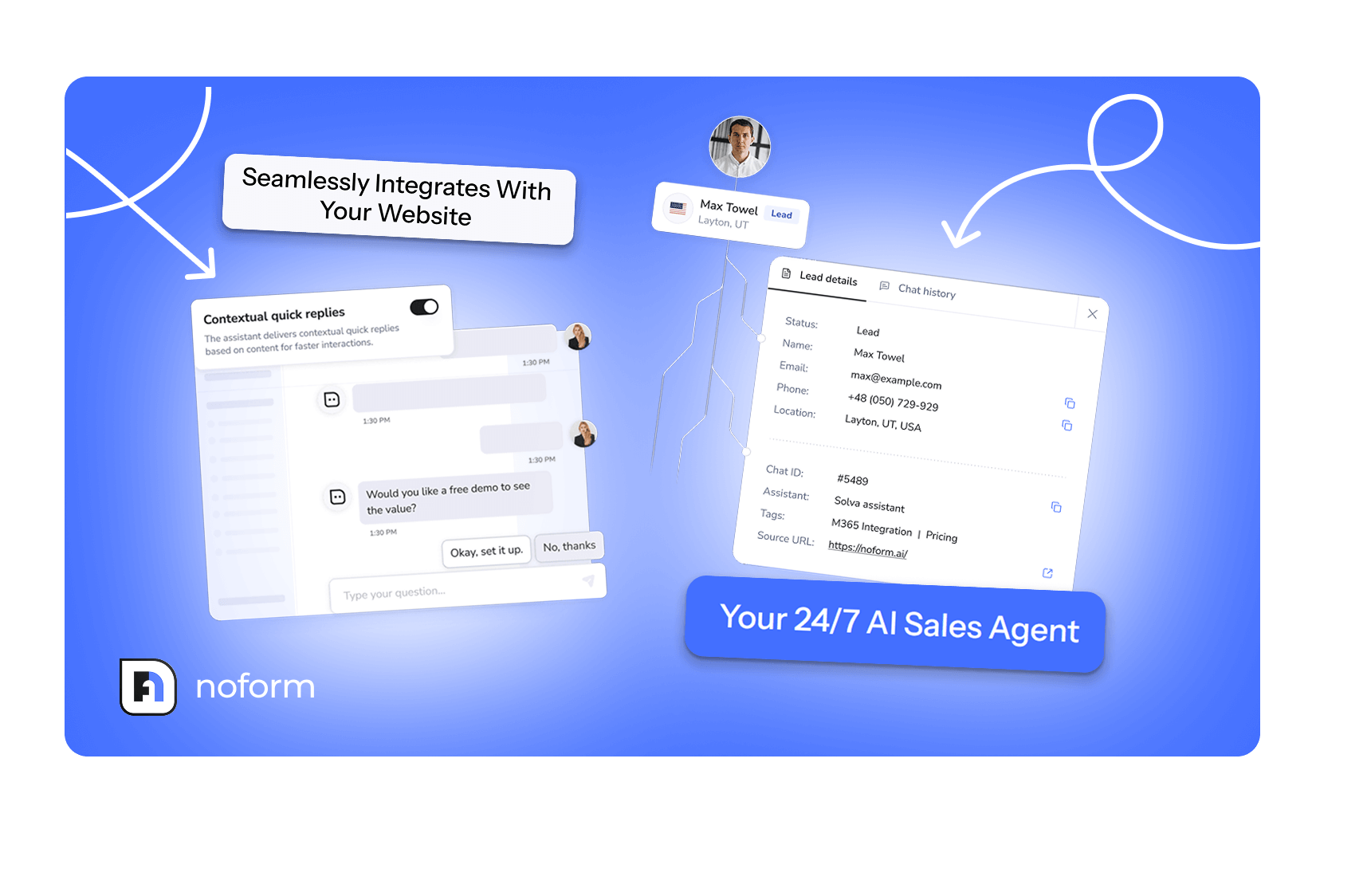
The platform handles the technical complexity for you, so you can focus on content, goals, and performance.
4. Train your bot
NoForm makes training easy with multiple content input options:
- Upload files: PDFs, DOCX, TXT
- Add URLs: Pull structured info from help centers, product pages, or blogs
- Manual instructions: Paste specific, high-priority answers directly into the bot
This makes it easy to pull in structured or unstructured content without worrying about formatting.
5. Customize the first message
First impressions matter, even in chat. Your welcome message sets the tone for the entire interaction, so make it count. Keep it friendly, clear, and focused on what the user can do next. Let them know they’ll get real help, not just canned replies.
For example:
“Hi! 👋 I’m here to help you find answers, get a quote, or learn more about our services.”
6. Set conversation starters (to drive engagement)
Guide the interaction from the start with clickable prompts that drive engagement. These help users get straight to the point.
Here are just a few quick reply option examples:
- “How do I get started?”
- “What’s the pricing?”
- “Do you offer support?”
7. Test, launch & improve
Once your bot’s ready, drop one lightweight script into your site and go live. Use NoForm AI’s built-in analytics to monitor performance, track missed questions, and retrain your bot based on real usage patterns.
Real-world success stories
When implemented thoughtfully, FAQ chatbots deliver real business results—at scale. Here’s how two very different companies used NoForm AI to create FAQ chatbots that solve real business problems and drive meaningful results.
Cheqmark: Transformed app onboarding with real-time answers
Cheqmark’s support team was overwhelmed with repetitive questions about platform features and checklist templates. Despite having the answers buried in help docs, users weren’t finding them fast enough—and conversions were lagging.
With NoForm AI’s FAQ chatbot, Cheqmark gave users instant access to answers, right when and where they needed them. The bot handled onboarding questions, explained key features, and helped users navigate the platform more efficiently.
The result? A 200% increase in conversions on key template pages, 38.8% more engagement in the template gallery, and a clear shift in user behavior. Instead of searching blindly or contacting support, users got answers through fast, conversational guidance.
Dog Gone Taxi: Streamlined pet transport quotes & boosted conversion
Dog Gone Taxi faced a flood of repeated FAQs—covering pricing, booking, regulations, and pet travel prep. Their team spent too much time answering the same questions, and potential leads dropped off after hours with no one available to help.
By deploying a NoForm AI FAQ chatbot, they automated the entire pre-sale experience. The bot answered booking-related questions, explained travel policies, and collected all key details to generate accurate quotes—24/7.
The chatbot engaged over 50,000 website visitors, replied to 3,300 user queries, and drove a 37% increase in qualified leads!
Conclusion
From lean startups to large enterprises, FAQ chatbots work across industries and company sizes. They reduce support load, speed up resolutions, and help teams focus on higher-impact work.
The key is choosing the right type of FAQ chatbot and using a chatbot builder that suits your needs.
Get started with a 7-day free trial at NoForm AI or book a demo to see how it fits your business.

